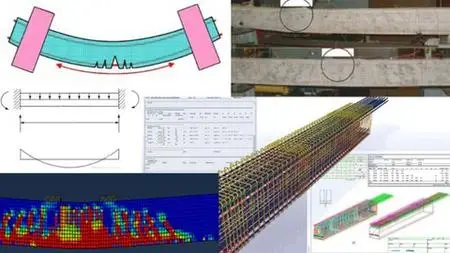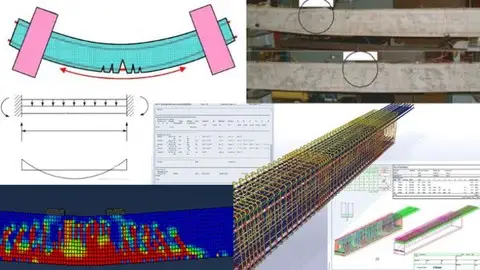Etabs Vs Manual Design: Rcc Beam Design As Per Is 456:2000
Published 11/2023
MP4 | Video: h264, 1920x1080 | Audio: AAC, 44.1 KHz
Language: English | Size: 3.80 GB | Duration: 7h 3m
Published 11/2023
MP4 | Video: h264, 1920x1080 | Audio: AAC, 44.1 KHz
Language: English | Size: 3.80 GB | Duration: 7h 3m
Develop confidence in RCC design manually and in software as well.
What you'll learn
Complete manual design design philosophy of RCC beam and detailed understanding of beam design in ETABS
It will help the participant to develop strong understanding of manual and software design.
It will help the participant to develop confidence while working on software and design.
Participant will be learn to how to understand software design design steps in detail.
Requirements
Personal computer with ETABS installed, pen, paper and internet.
Description
1. Fundamentals of Beam Design Philosophy2. Signly Reinforced Beam3. Doundly Reinforced Beam4. IS456: 2000 Reference5. Complete Manual Design for Flexure with Example (hand calc)6. Complete Manual Design for Shear with Example (hand calc)7. Complete Design for Flexure with Example in ETABS 8. Complete Design for Shear with Example in ETABS9. Understanding Complete Design Report in ETABS step by stepThe design of reinforced concrete (RCC) beams in accordance with IS 456:2000, the Indian Standard Code of Practice for Plain and Reinforced Concrete, involves several steps. The design philosophy is based on ensuring that the beams are capable of safely resisting the loads they are subjected to while conforming to specified criteria. Here is a summary of the design philosophy for RCC beams according to IS 456:2000:Structural Safety:The primary objective is to ensure the safety and stability of the structure under different loading conditions.Adequate strength and stability should be provided to resist the applied loads, including dead loads, live loads, wind loads, and other relevant loads.Material Properties:The design is based on the properties of the materials used, such as concrete and steel. Relevant material strengths and characteristics are considered in the calculations.Limit State Design:IS 456:2000 adopts the limit state design philosophy, which involves considering two limit states: the Ultimate Limit State (ULS) and the Serviceability Limit State (SLS).The Ultimate Limit State ensures that the structure can safely support the maximum expected loads without failure.The Serviceability Limit State ensures that the structure remains serviceable under normal conditions, without excessive deflections or cracking.Loading Conditions:Different loading conditions, including dead loads, live loads, and other applicable loads, are considered during the design process.Load combinations are specified to account for various loading scenarios, such as the combination of dead load and live load.Strength Reduction Factors:The design involves applying strength reduction factors to the material strengths to ensure a margin of safety. These factors account for uncertainties in material properties and workmanship.Flexural and Shear Design:For beams, the design involves checking for flexural strength (moment capacity) and shear strength.The bending moment and shear force distribution along the length of the beam are considered, and the beam is designed to satisfy equilibrium and compatibility conditions.Ductility Considerations:Ductility is an essential aspect of the design philosophy, especially in seismic-prone areas. The design should provide a level of ductility to ensure that the structure can undergo deformations without sudden failure during earthquakes.Code Requirements:Designers must adhere to the specific requirements and guidelines outlined in IS 456:2000. This includes detailing and construction practices to ensure the structural integrity of the designed beams.
Overview
Section 1: Manual Design- IS456:2000
Lecture 1 Fundamentals of RCC Beam Design Philosophy
Lecture 2 Fundamentals of RCC Beam Design Philosophy-02
Lecture 3 Singly Reinforced Beam Design
Lecture 4 Doubly Reinforced Beam Design
Lecture 5 Shear Design of RCC Beam
Lecture 6 Torsion Design (Equvalent Moment & Shear)
Section 2: ETABS Software Design-IS456:2000
Lecture 7 Design of RCC Beam in ETABS
Lecture 8 Deflection Check of Beam in ETABS
Civil/Structural Engineers,Civil Engineering Students



